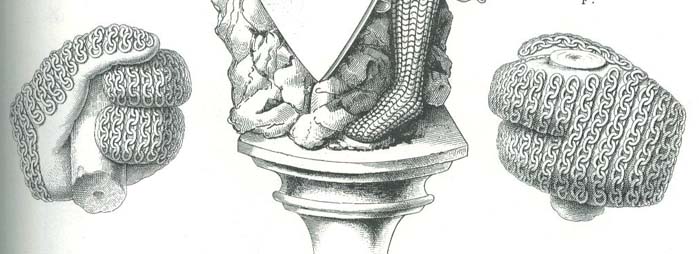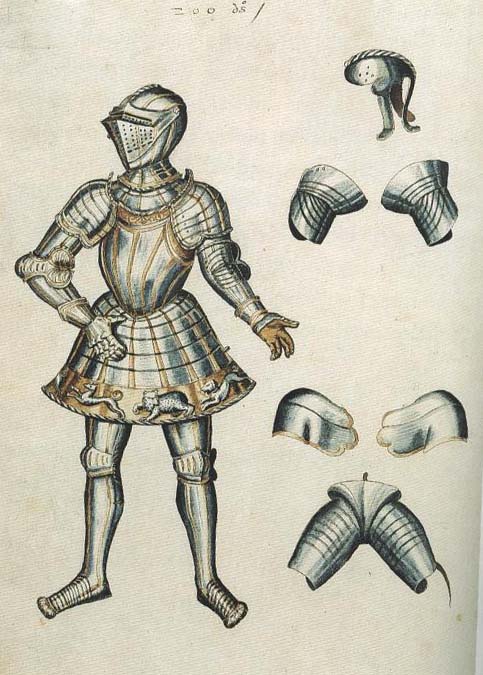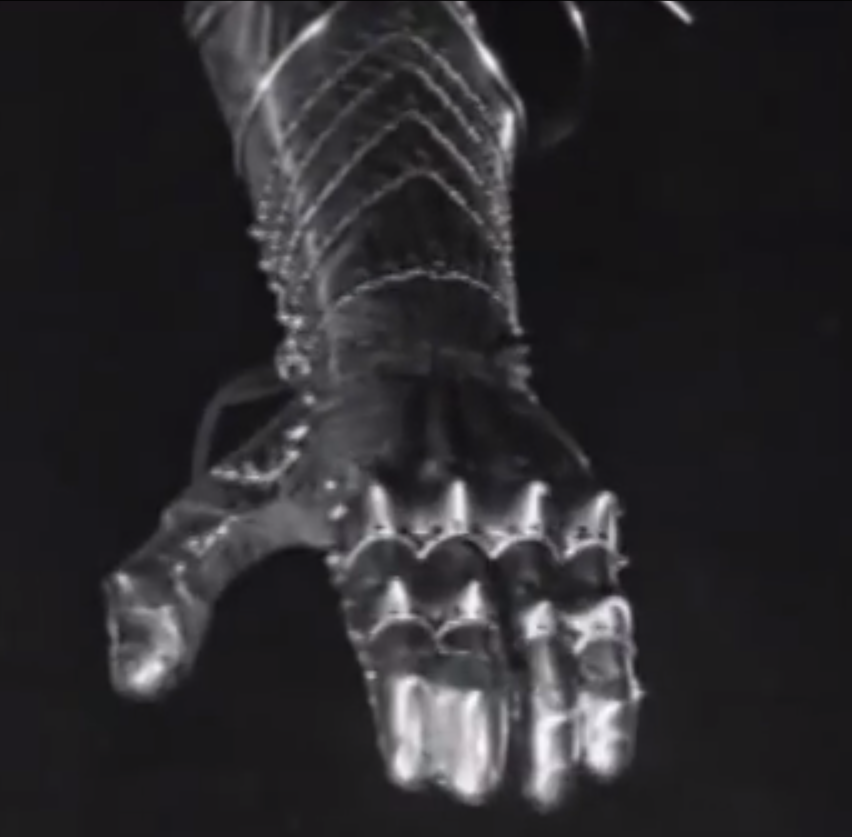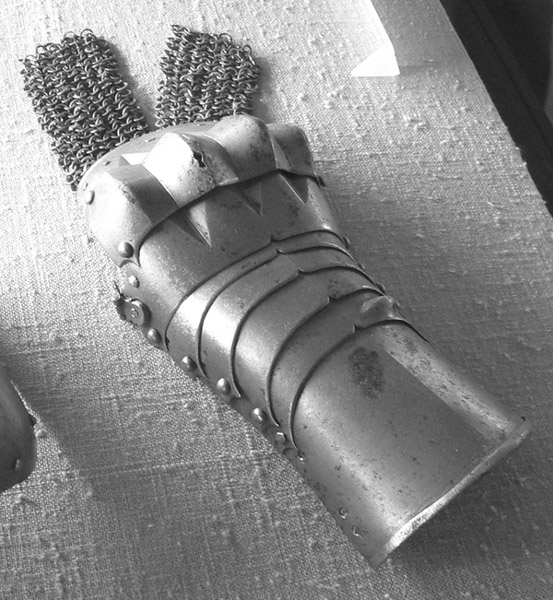| Author |
Message |
Chad Arnow
myArmoury Team


|
 Posted: Sat 04 Feb, 2006 11:47 am Post subject: More examples of bifurcated (split-mitten) gauntlets? Posted: Sat 04 Feb, 2006 11:47 am Post subject: More examples of bifurcated (split-mitten) gauntlets? |
 |
|
I cam across some images in some of my books that have me intrigued. We've all seen finger gauntlets and mitten gauntlets. But, there are apparently some that fall in between, which I called split-mitten for lack of a better term.
These have thumbs and places for pairs of fingers. Anyone have any more pictures of these? My own (limited) experience comes from finger gauntlets. What would be the advantages of things like these over finger or mitten gauntlets?
 Attachment: 47.13 KB Attachment: 47.13 KB

Split mail mittens from Hefner-Alteneck's Medieval Arms & Armor
 Attachment: 33.82 KB Attachment: 33.82 KB

Tonlet Armour of Charles V from Resplendence of the Spanish Monarchy
 Attachment: 34.47 KB Attachment: 34.47 KB

Detail of gauntlet
 Attachment: 74.88 KB Attachment: 74.88 KB

Drawing of harness

ChadA
http://chadarnow.com/
Last edited by Chad Arnow on Sat 04 Feb, 2006 12:24 pm; edited 1 time in total
|
|
    |
 |
Nathan Robinson
myArmoury Admin


|
|
    |
 |
Chad Arnow
myArmoury Team


|
 Posted: Sat 04 Feb, 2006 12:07 pm Post subject: Posted: Sat 04 Feb, 2006 12:07 pm Post subject: |
 |
|
Interesting term.
bifurcated
adj : divided into or made up of two parts

ChadA
http://chadarnow.com/
|
|
    |
 |
Bill Grandy
myArmoury Team


|
 Posted: Sat 04 Feb, 2006 12:23 pm Post subject: Posted: Sat 04 Feb, 2006 12:23 pm Post subject: |
 |
|
I've always called them the Ninja Turtle gauntlets, but yes, I've generally heard the term bifurcated. I imagine this is a modern term, though I don't know for certain.
As for advantages, in mail I guess it's a little easier to make. In plate it would imagine that it gives a little more shock absorbancy than typical finger gauntlets, with a little more dexterity than with mitten gauntlets. Though I don't know exactly what the benefit would be to having the fingers functiion this way as opposed to the other aforementioned designs. It doesn't seem to have a benefit in terms of weapons handling, in my opinion... perhaps it has to do with riding a horse? Perhaps something entirely else?
HistoricalHandcrafts.com
-Inspired by History, Crafted by Hand
"For practice is better than artfulness. Your exercise can do well without artfulness, but artfulness is not much good without the exercise.” -anonymous 15th century fencing master, MS 3227a
|
|
   |
 |
|
R. D. Simpson
|
 Posted: Sat 04 Feb, 2006 12:33 pm Post subject: Posted: Sat 04 Feb, 2006 12:33 pm Post subject: |
 |
|
| Bill Grandy wrote: | | It doesn't seem to have a benefit in terms of weapons handling, in my opinion... perhaps it has to do with riding a horse? |

When my father taught me to ride, he told me to hold the reins with the fore and middle fingers and thumb, while keeping my ring and little fingers curled as if in a fist. I don't know if this is a traditional way to grip the reins, but if it is, it might account for these bifurcated gauntlets.
|
|
  |
 |
|
Don Stanko
|
 Posted: Sat 04 Feb, 2006 12:39 pm Post subject: Posted: Sat 04 Feb, 2006 12:39 pm Post subject: |
 |
|
|
Thats interesting. I don't know what the advantage would have been but I've seen this pattern used before. When armourers created prosthetic hands made of iron, like the appendages made for Gotz, they used this very pattern for the fingers. They moved in pairs and locked in place to hold items like a saddle harness. Just a thought...
|
|
  |
 |
James Arlen Gillaspie
Industry Professional

Location: upstate NY Joined: 10 Nov 2005
Posts: 587
|
 Posted: Sat 04 Feb, 2006 6:13 pm Post subject: Posted: Sat 04 Feb, 2006 6:13 pm Post subject: |
 |
|
Tonlet armours are for foot-combat.
jamesarlen.com
|
|
   |
 |
|
R. D. Simpson
|
 Posted: Sat 04 Feb, 2006 7:53 pm Post subject: Posted: Sat 04 Feb, 2006 7:53 pm Post subject: |
 |
|
| James Arlen Gillaspie wrote: | | Tonlet armours are for foot-combat. |
I was under the impression that the tonlet, or at least a portion of it, could usually be removed to accommodate mounted combat. Have I been misinformed?
|
|
  |
 |
Chad Arnow
myArmoury Team


|
 Posted: Sat 04 Feb, 2006 8:14 pm Post subject: Posted: Sat 04 Feb, 2006 8:14 pm Post subject: |
 |
|
| R. D. Simpson wrote: |
I was under the impression that the tonlet, or at least a portion of it, could usually be removed to accommodate mounted combat. Have I been misinformed? |
I don't think every tonlet armour was convertable.  There is at least one famous example where part of the skirt is removeable to make the wearer able to ride, but this one doesn't seem to have that feature. There is at least one famous example where part of the skirt is removeable to make the wearer able to ride, but this one doesn't seem to have that feature.

ChadA
http://chadarnow.com/
|
|
    |
 |
|
R. D. Simpson
|
 Posted: Sat 04 Feb, 2006 8:38 pm Post subject: Posted: Sat 04 Feb, 2006 8:38 pm Post subject: |
 |
|
| Chad Arnow wrote: | | R. D. Simpson wrote: |
I was under the impression that the tonlet, or at least a portion of it, could usually be removed to accommodate mounted combat. Have I been misinformed? |
I don't think every tonlet armour was convertable.  There is at least one famous example where part of the skirt is removeable to make the wearer able to ride, but this one doesn't seem to have that feature. There is at least one famous example where part of the skirt is removeable to make the wearer able to ride, but this one doesn't seem to have that feature. |
Thanks for the correction.
|
|
  |
 |
Elling Polden

|
 Posted: Sun 05 Feb, 2006 2:38 am Post subject: Posted: Sun 05 Feb, 2006 2:38 am Post subject: |
 |
|
These split mittens where quite common in civilian use. They give a bit better manual dexterity than mittens, and are as such handy if you are going to perform actual work.
They where probably just directly adapted to armour, and probably has no great protection or handling advantage.
But they would be a lot easier to make than regular finger gauntlets...
"this [fight] looks curious, almost like a game. See, they are looking around them before they fall, to find a dry spot to fall on, or they are falling on their shields. Can you see blood on their cloths and weapons? No. This must be trickery."
-Reidar Sendeman, from King Sverre's Saga, 1201
|
|
    |
 |
|
Gregory J. Liebau
Location: Dinuba, CA Joined: 27 Nov 2004
Posts: 669
|
 Posted: Sun 05 Feb, 2006 1:12 pm Post subject: Posted: Sun 05 Feb, 2006 1:12 pm Post subject: |
 |
|
I found another nice example of a bifurcated gauntlet on Jason Grimes' site, but it's a private gallery, so I can't reproduce the image. He dated it to the late 15th century. Out of curiousity, can someone give me the approximate date that the Charles V tonlet harness was made?
Thanks!
-Gregory-
My Flickr Galleries - Travel, Nature & Things
|
|
  |
 |
Chad Arnow
myArmoury Team


|
 Posted: Sun 05 Feb, 2006 1:18 pm Post subject: Posted: Sun 05 Feb, 2006 1:18 pm Post subject: |
 |
|
| Gregory J. Liebau wrote: | Out of curiousity, can someone give me the approximate date that the Charles V tonlet harness was made?
|
The book lists it as 1520-1530.

ChadA
http://chadarnow.com/
|
|
    |
 |
James Arlen Gillaspie
Industry Professional

Location: upstate NY Joined: 10 Nov 2005
Posts: 587
|
 Posted: Sun 05 Feb, 2006 7:23 pm Post subject: Posted: Sun 05 Feb, 2006 7:23 pm Post subject: |
 |
|
It is not uncommon for harness of this type (and this Charles V harness is a perfect example) to have a heavy (relatively speaking) mitten gauntlet on the right hand and a split mitten of some sort on the left. When I saw this harness in Madrid, it was in a case with a similar harness, only its left gauntlet had THREE fingers together and an articulated pinkie (!). Speaking for myself as someone who makes and uses armour, this is the sort of arrangement I would ideally prefer, only possibly a full-blown fingered gauntlet on my left hand. It's the fingers that tend to get hit on the right hand, and the knuckles on the left.
jamesarlen.com
|
|
   |
 |
|
Peter Törlind
|
 Posted: Mon 11 Aug, 2014 2:11 pm Post subject: METs bifurcated Posted: Mon 11 Aug, 2014 2:11 pm Post subject: METs bifurcated |
 |
|
Anyone has some more info on the bifurcated gauntlet in this old video?
http://youtu.be/NjKbi7YUNaI?t=8m30s

 Attachment: 363.05 KB Attachment: 363.05 KB
Bifurcated gauntlet from the MET video from 1920 [ Download ]
Last edited by Peter Törlind on Mon 11 Aug, 2014 10:43 pm; edited 1 time in total
|
|
  |
 |
Mark T

|
 Posted: Mon 11 Aug, 2014 3:30 pm Post subject: Posted: Mon 11 Aug, 2014 3:30 pm Post subject: |
 |
|
Peter: great video - thanks!
I've also recently become interested in bifurcated gauntlets, especially those with mail on the fingers. At The Armour Archive last year, Jason Grimes wondered if these may have been used with crossbows, as they give more finger dexterity than fully-plated fingers; the question was then asked if they'd provide enough dexterity to remove arrows/bolts from quivers ... if anyone has any documented sources or strong opinions on this design, I'd be interested in hearing them.
In the meantime, here's a pair from the Bayerisches Armeemuseum Museum Ingolstadt. Pic is from Arma Bohemia's website; they're currently offering a pair based on them.
 Attachment: 110.84 KB Attachment: 110.84 KB

Chief Librarian/Curator, Isaac Leibowitz Librarmoury
Schallern sind sehr sexy!
|
|
  |
 |
|
|

